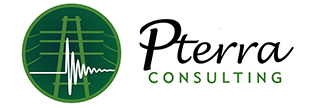In study after study, we (Pterra) are encountering this seemingly mounting issue of ride-through capability in solar photovoltaic (“PV”) inverters. For now, the matter is isolated to frequency ride-through in small grids such as those that may be found in the Hawaiian islands.  However, there is potential for this to be critical in even larger systems as the number of inverter-based PV arrays interconnecting to existing distribution and transmission systems increases.
However, there is potential for this to be critical in even larger systems as the number of inverter-based PV arrays interconnecting to existing distribution and transmission systems increases.
The crux of the present issue relates to the frequency ride-through settings and capability for commercial PV inverters. The industry standard that addresses frequency settings for solar PV is IEEE standard 1547, Interconnecting Distributed Resources With Electric Power Systems, which specifies that (for 60 Hz systems):
- For inverters < 30 kW, trip at frequency < 59.3 Hz clearing in 0.16 sec
- For inverters > 30 kW, trip at frequencies 57-59.8 Hz clearing in 0.16 to 300 sec (adjustable setpoint), or at frequency < 57 Hz clearing in 016 sec
Certain commercial PV inverters are equipped with extended frequency ride-through capability that will not trip until frequency drops below 55 Hz.


 Our core competencies remain the same: power engineering analysis, new technologies, modeling and simulation. But service applications have grown, from the initial focus on transmission planning and interconnection of new generation, Pterra now offers distributed generation studies, solar photovoltaic and wind power modeling, applications training, assessment for high voltage direct current transmission, expert witness, among others.
Our core competencies remain the same: power engineering analysis, new technologies, modeling and simulation. But service applications have grown, from the initial focus on transmission planning and interconnection of new generation, Pterra now offers distributed generation studies, solar photovoltaic and wind power modeling, applications training, assessment for high voltage direct current transmission, expert witness, among others.
 DG to the existing electric grid to ensure it would not adversely impact the operation, reliability and safety of the grid. By its nature, DG would interconnect to lower voltage systems generally classified as “distribution”. The studies can range from relatively quick feasibility assessments to comprehensive studies involving extensive equipment and power system modeling, measurements, and detailed simulations. Specific topics for such studies include: islanding, steady state power flow, voltage regulation, short-circuit, protective relaying, power quality (flicker and harmonic), power factor, system stability, grounding, and ground fault overvoltage.
DG to the existing electric grid to ensure it would not adversely impact the operation, reliability and safety of the grid. By its nature, DG would interconnect to lower voltage systems generally classified as “distribution”. The studies can range from relatively quick feasibility assessments to comprehensive studies involving extensive equipment and power system modeling, measurements, and detailed simulations. Specific topics for such studies include: islanding, steady state power flow, voltage regulation, short-circuit, protective relaying, power quality (flicker and harmonic), power factor, system stability, grounding, and ground fault overvoltage.